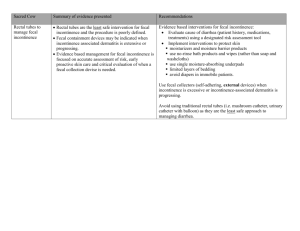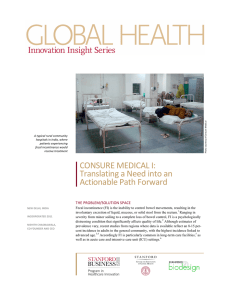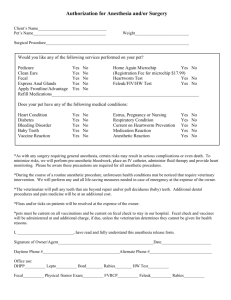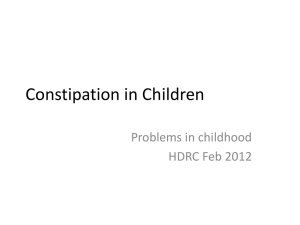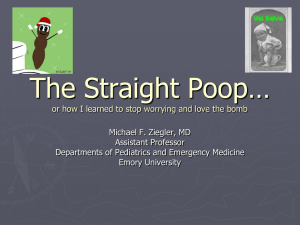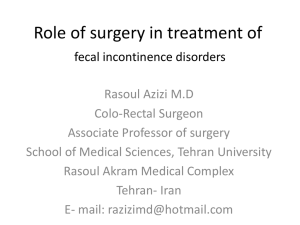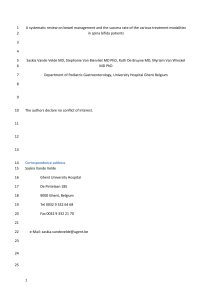Fecal Incontinence (Encopresis) In Childhood
advertisement
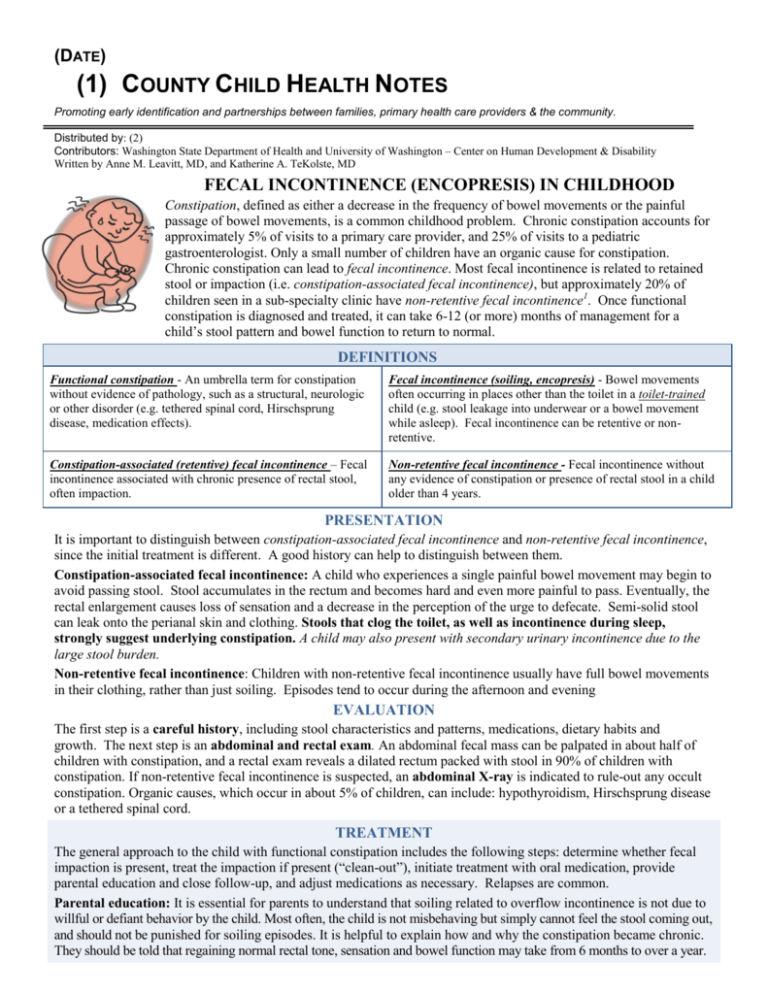
(DATE) (1) COUNTY CHILD HEALTH NOTES Promoting early identification and partnerships between families, primary health care providers & the community. Distributed by: (2) Contributors: Washington State Department of Health and University of Washington – Center on Human Development & Disability Written by Anne M. Leavitt, MD, and Katherine A. TeKolste, MD FECAL INCONTINENCE (ENCOPRESIS) IN CHILDHOOD Constipation, defined as either a decrease in the frequency of bowel movements or the painful passage of bowel movements, is a common childhood problem. Chronic constipation accounts for approximately 5% of visits to a primary care provider, and 25% of visits to a pediatric gastroenterologist. Only a small number of children have an organic cause for constipation. Chronic constipation can lead to fecal incontinence. Most fecal incontinence is related to retained stool or impaction (i.e. constipation-associated fecal incontinence), but approximately 20% of children seen in a sub-specialty clinic have non-retentive fecal incontinence1. Once functional constipation is diagnosed and treated, it can take 6-12 (or more) months of management for a child’s stool pattern and bowel function to return to normal. DEFINITIONS Functional constipation - An umbrella term for constipation without evidence of pathology, such as a structural, neurologic or other disorder (e.g. tethered spinal cord, Hirschsprung disease, medication effects). Fecal incontinence (soiling, encopresis) - Bowel movements often occurring in places other than the toilet in a toilet-trained child (e.g. stool leakage into underwear or a bowel movement while asleep). Fecal incontinence can be retentive or nonretentive. Constipation-associated (retentive) fecal incontinence – Fecal incontinence associated with chronic presence of rectal stool, often impaction. Non-retentive fecal incontinence - Fecal incontinence without any evidence of constipation or presence of rectal stool in a child older than 4 years. PRESENTATION It is important to distinguish between constipation-associated fecal incontinence and non-retentive fecal incontinence, since the initial treatment is different. A good history can help to distinguish between them. Constipation-associated fecal incontinence: A child who experiences a single painful bowel movement may begin to avoid passing stool. Stool accumulates in the rectum and becomes hard and even more painful to pass. Eventually, the rectal enlargement causes loss of sensation and a decrease in the perception of the urge to defecate. Semi-solid stool can leak onto the perianal skin and clothing. Stools that clog the toilet, as well as incontinence during sleep, strongly suggest underlying constipation. A child may also present with secondary urinary incontinence due to the large stool burden. Non-retentive fecal incontinence: Children with non-retentive fecal incontinence usually have full bowel movements in their clothing, rather than just soiling. Episodes tend to occur during the afternoon and evening EVALUATION The first step is a careful history, including stool characteristics and patterns, medications, dietary habits and growth. The next step is an abdominal and rectal exam. An abdominal fecal mass can be palpated in about half of children with constipation, and a rectal exam reveals a dilated rectum packed with stool in 90% of children with constipation. If non-retentive fecal incontinence is suspected, an abdominal X-ray is indicated to rule-out any occult constipation. Organic causes, which occur in about 5% of children, can include: hypothyroidism, Hirschsprung disease or a tethered spinal cord. TREATMENT The general approach to the child with functional constipation includes the following steps: determine whether fecal impaction is present, treat the impaction if present (“clean-out”), initiate treatment with oral medication, provide parental education and close follow-up, and adjust medications as necessary. Relapses are common. Parental education: It is essential for parents to understand that soiling related to overflow incontinence is not due to willful or defiant behavior by the child. Most often, the child is not misbehaving but simply cannot feel the stool coming out, and should not be punished for soiling episodes. It is helpful to explain how and why the constipation became chronic. They should be told that regaining normal rectal tone, sensation and bowel function may take from 6 months to over a year. Disimpaction (clean-out): This is necessary before maintenance therapy can be started, and can usually be achieved as an outpatient, with oral medication. Polyethylene glycol (PEG 3350 powder: Miralax) has been shown to be effective. High dose mineral oil (in children >1 year old and not at risk of aspiration), senna, or bisocodyl can be added if necessary. This is usually done for 3 days, and can be repeated once/week for several weeks if needed. This step is skipped for children with non-retentive fecal incontinence. Maintenance: The child will need close follow-up and monitoring to adjust medication as necessary. The goal is to maintain soft bowel movements once or twice a day. It may take 6-12+ months of treatment for rectal tone and sensation to return to normal. Miralax is the most commonly used medication for maintenance. Increased dietary fiber and hydration are helpful, but not sufficient on their own. Behavioral interventions: This is an essential component of treatment. The child should be encouraged to sit on the toilet for 5-10 minutes after meals. The child should be rewarded for effort (sitting) rather than success (evacuation in the toilet). A diary should be used to record bowel movements, medication and episodes of fecal incontinence, abdominal pain, and wetting. School and daycare need to be included in the plan for accommodations such as unrestricted access to the bathroom, access to a private bathroom, or use of a unobstrusive signal to let the teacher know of the need to use the toilet. Referral to a child psychologist may be indicated to assist parents with management strategies. RESOURCES Clinical Practice Guideline: Evaluation and Treatment of Constipation in Infants and Children: Recommendations of the North American Society for Pediatric Gastroenterology, Hepatology and Nutrition. Journal of Pediatric Gastroenterology and Nutrition 43: e1-e13, September 2006 http://www.naspghan.org/user-assets/Documents/pdf/PositionPapers/constipation.guideline.2006.pdf Parent information: • North American Society for Pediatric Gastroenterology, Hepatology and Nutrition (NASPGHAN): http://naspghan.org/user-assets/Documents/pdf/Public%20Education%20Brochures/2011/FECAL%20SOILING%20ENG%20REV12-10.pdf • Nemours Foundation: http://kidshealth.org/parent/emotions/behavior/encopresis.html • AAP: http://www.healthychildren.org/English/health-issues/conditions/emotional-problems/pages/Soiling-Encopresis.aspx • NIH: http://digestive.niddk.nih.gov/ddiseases/pubs/constipationchild/index.aspx Special Needs Information and Resources: (3) (4) (5) WithinReach Family Health Hotline ParentHelp123.org Early Support for Infants and Toddlers Program (formerly ITEIP) 1-800-322-2588, 1-800-833-6388 TTD www.withinreachwa.org The Center for Children with Special Needs www.ParentHelp123.org http://del.wa.gov/development/esit/ Main number: (360) 725-3500 (800) 821-5927 www.arcwa.org/parent_to_parent.htm http://www.cshcn.org Washington State Medical Home http://www.medicalhome.org American Academy of Pediatrics AAP Developmental and Behavioral Pediatrics American Academy of Family Physicians CDC Act Early Family Village (Extensive family resources for CSHCN) Family Voices (Links to national and state family support networks) Nutrition for Children with Special Health Care Needs in WA State CSHCN Nutrition Network Washington State Community Feeding Teams www.aap.org www.dbpeds.org www.aafp.org www.cdc.gov/ncbddd/actearly/index.html www.familyvillage.wisc.edu www.familyvoices.org http://depts.washington.edu/cshcnnut/ http://depts.washington.edu/cshcnnut/nutnet/index.html http://depts.washington.edu/cshcnnut/feeding/index.html Parent to Parent Support Programs of Washington
